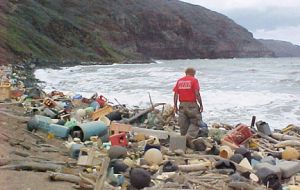MercoPress. South Atlantic News Agency
Floating plastic junk widely spread on world oceans but doubts about how much
 Plastic debris from land reaches the ocean mostly through storm water runoff, the researchers said in their report
Plastic debris from land reaches the ocean mostly through storm water runoff, the researchers said in their report  ”Concentrations were highest in five areas including west of southern South America and east and west of the southern tip of Africa.
”Concentrations were highest in five areas including west of southern South America and east and west of the southern tip of Africa. Plastic junk is floating widely on the world’s oceans, but there’s less of it than expected, a study says. Such ocean pollution has drawn attention in recent years because of its potential harm to fish and other wildlife.
The new work drew on results from an around-the-world cruise by a research ship that towed a mesh net at 141 sites, as well as other studies. Researchers estimated the total amount of floating plastic debris in open ocean at 7,000 to 35,000 tons.
Andres Cozar of the University of Cadiz in Spain, an author of the study, said that’s a lot less than the 1 million tons he had extrapolated from data reaching back to the 1970s.
The new estimate includes only floating debris, not plastic that may reside beneath the surface or on the ocean floor.
Some floating pieces start out small, like the micro-beads found in some toothpastes and cosmetics or industrial pellets used to make plastic products. Other small pieces can result when wave action breaks up larger objects, like bottle caps, detergent bottles and shopping bags.
The net turned up fewer small pieces than expected, and it will be important to figure out why, researchers said. Perhaps the tiniest pieces are being eaten by small fish, with uncertain effects on their health, Cozar said in an email.
While the research showed plastic to be distributed widely, concentrations were highest in five areas that were predicted by ocean current patterns. They are west of the U.S., between the U.S. and Africa, west of southern South America and east and west of the southern tip of Africa.
Plastic debris from land reaches the ocean mostly through storm water runoff, the researchers said in their report, released Monday by the Proceedings of the National Academy of Sciences.
Kara Lavender Law, who studies plastic pollution at the Sea Education Association in Massachusetts, said the study provides the first global estimate she knows of for floating plastic debris.
“We are putting, certainly by any estimate, a large amount of a synthetic material into a natural environment,” said Law, who didn’t participate in the new work. “We’re fundamentally changing the composition of the ocean.”
The impact on fish and birds is hard to gauge because scientists don’t understand things like how much plastic animals encounter and how they might be harmed if they swallow it, she said.




Top Comments
Disclaimer & comment rules-

-

-

Read all commentsJust when you think its safe to go into the water,
Jul 01st, 2014 - 10:21 am 0the plastic queens relatives turn up..lolol
Read this about a brilliant idea to clean the oceans of the floating plastics:
Jul 01st, 2014 - 11:44 am 0http://www.theoceancleanup.com/
Everything these days seems to be about recycling.
Jul 01st, 2014 - 01:58 pm 0Could this stuff be cleaned up and recycled?
Personally I doubt that it would be cost effective.
Commenting for this story is now closed.
If you have a Facebook account, become a fan and comment on our Facebook Page!